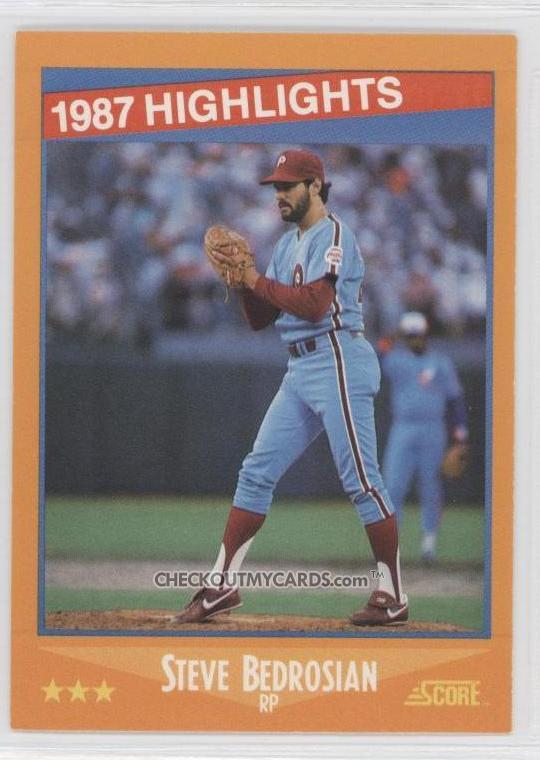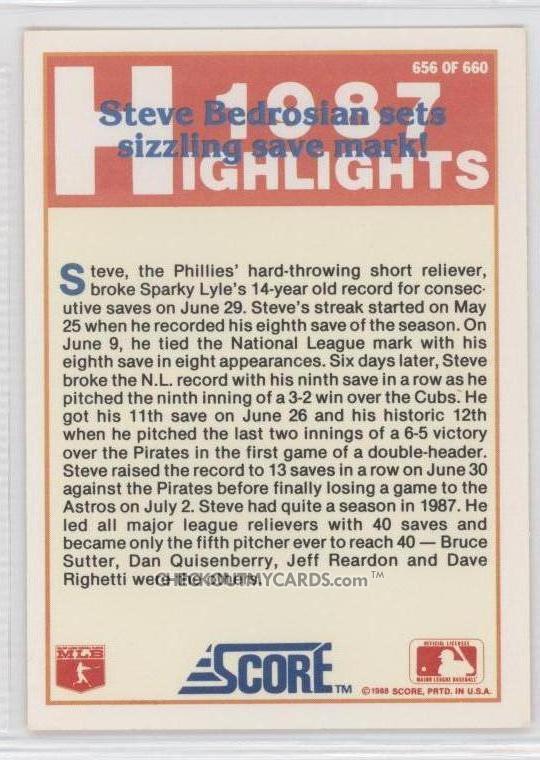25 years ago today, on June 29th 1987, Steve Bedrosian recorded a save in a 6-5 Phillies win over the Pirates. It was the 19th save of his Cy Young-winning season, and it was the 12th straight appearance where he recorded a save.
Read the last part of that last sentence again…he got a save in 12 straight appearances. That doesn’t sound too unusual, right? Can you believe that at the time, he had just set the MLB record for most consecutive appearances with a save?
The card above actually celebrates that very streak. Read the back of the card, posted at the bottom here. At the time, Bedrosian’s record-breaking performance supplanted that of Sparky Lyle from 14 years prior.
In the 25 years that followed Bedrosian’s record, here are the longest streaks where a pitcher recorded a save in every appearance:
| Rk | Strk Start | End | Games | |
|---|---|---|---|---|
| 1 | John Wetteland | 1996-05-31 | 1996-07-14 | 24 |
| 2 | Todd Jones | 2005-07-19 | 2005-09-13 | 23 |
| 3 | Lee Smith | 1995-04-28 | 1995-06-25 | 19 |
| 4 | J.J. Putz | 2011-08-12 | 2011-09-25 | 18 |
| 5 | Lee Smith | 1993-05-24 | 1993-06-28 | 17 |
| 6 | Randy Myers | 1993-09-03 | 1993-10-03 | 16 |
| 7 | Jose Valverde | 2008-08-09 | 2008-09-10 | 15 |
| 8 | Chad Cordero | 2005-06-05 | 2005-07-02 | 15 |
| 9 | Jose Mesa | 2004-09-26 | 2005-05-10 | 15 |
| 10 | Trevor Hoffman | 2001-07-19 | 2001-09-01 | 15 |
| 11 | Kazuhiro Sasaki | 2000-06-20 | 2000-07-28 | 15 |
| 12 | Jeff Shaw | 1997-08-25 | 1997-09-19 | 15 |
| 13 | Doug Jones | 1988-05-13 | 1988-07-02 | 15 |
| 14 | Mariano Rivera | 2003-08-19 | 2003-09-19 | 14 |
| 15 | John Smoltz | 2002-06-03 | 2002-07-01 | 14 |
| 16 | Rod Beck | 1998-06-28 | 1998-07-26 | 14 |
| 17 | Mariano Rivera | 1998-06-02 | 1998-07-11 | 14 |
| 18 | Jose Mesa | 1995-05-20 | 1995-06-17 | 14 |
| 19 | Jeff Montgomery | 1994-07-08 | 1994-08-09 | 14 |
| 20 | Ryan Franklin | 2009-08-07 | 2009-09-05 | 13 |
| 21 | Joakim Soria | 2008-09-06 | 2009-04-22 | 13 |
| 22 | Francisco Rodriguez | 2008-04-14 | 2008-05-13 | 13 |
| 23 | Francisco Rodriguez | 2005-09-17 | 2006-04-10 | 13 |
| 24 | Bob Wickman | 2005-08-23 | 2005-09-23 | 13 |
| 25 | Trevor Hoffman | 2005-04-30 | 2005-05-29 | 13 |
| Rk | Strk Start | End | Games | |
| 26 | Troy Percival | 2003-06-08 | 2003-07-09 | 13 |
| 27 | John Wetteland | 2000-05-12 | 2000-06-05 | 13 |
| 28 | Jeff Montgomery | 1998-06-17 | 1998-07-24 | 13 |
| 29 | Lee Smith | 1993-10-01 | 1994-04-30 | 13 |
| 30 | Rod Beck | 1993-05-21 | 1993-06-21 | 13 |
| 31 | Dennis Eckersley | 1992-04-25 | 1992-05-29 | 13 |
| 32 | Steve Bedrosian | 1987-05-25 | 1987-06-30 | 13 |
| 33 | Jonathan Broxton | 2010-05-07 | 2010-05-30 | 12 |
| 34 | Jason Isringhausen | 2004-08-05 | 2004-09-01 | 12 |
| 35 | Mariano Rivera | 2004-05-26 | 2004-06-15 | 12 |
| 36 | Joe Borowski | 2003-09-04 | 2004-04-09 | 12 |
| 37 | Troy Percival | 2002-06-02 | 2002-07-03 | 12 |
| 38 | Rod Beck | 1996-09-28 | 1997-04-27 | 12 |
| 39 | Mark Davis | 1988-10-01 | 1989-04-29 | 12 |
| 40 | John Franco | 1988-07-05 | 1988-07-30 | 12 |
You can see Bedrock ran his streak to 13 games, but since setting his record, it’s been tied or broken 31 times. Insane.
The way that closers get used now is so exclusively in save situations, that any guy who doesn’t get a blown save for a couple of months will rack up a streak that ties Bedrosian’s 1987 record.
I don’t even really know where to begin with the stupidity of how closers are used today. The dumbest thing of all is a road team saving a closer for when they have a lead. If it’s the bottom of the 9th (or 10th or 11th, etc) and the score is tied, managers just about never use their closers. They “save” him (ironically enough) for the next inning in the hopes that their team scores in the top of the inning so they can then bring in the closer to protect the lead. That means that the manager puts in a lesser reliever to pitch that inning, and if he gives up a run, the game is over while your closer is still sitting on his ass, having never come into the game.
I do miss the days of Goose Gossage, who routinely came in during the 7th or 8th inning to pitch 2 to 3 innings to close out games. It seems to make a lot more sense. I understand, though, that limiting a closer to 1 inning (and usually fewer pitches) means he’ll throw harder, batters have less opportunity to see the pitcher, and generally he will be more effective. But I can’t help but feel that managers have swung too far in the other direction, limiting the user of closers far too much.
When Joe Torre started using Mariano Rivera in the playoffs in the 8th inning, I had hoped that this would carry over to the regular season and that Rivera would be the first of a new breed of closers who would come in for as many as 6 outs. But this hasn’t happened, presumably because on the rare occasions when a closer blows a game in such circumstances because he’s lost an MPH or two off his fastball, managers feel like they would have been better off saving him for the 9th. But the current prevailing strategy has been shown to be monumentally flawed…
It takes time I suppose. I feel pretty confident in saying that in another 10 years time, closers will not be used in such restricted circumstances. Joe Madden will probably be the first guy to figure it out.
If you’ve read this far, you get a prize. Take a look again at the picture of Bedrosian on the front of the card at the top of this post. Notice anything unusual?
There is a Montreal Expo in the background who is not a baserunner, but an infielder. This means that the photo can only be from the 1987 All-Star game, and that must be Hubie Brooks.


